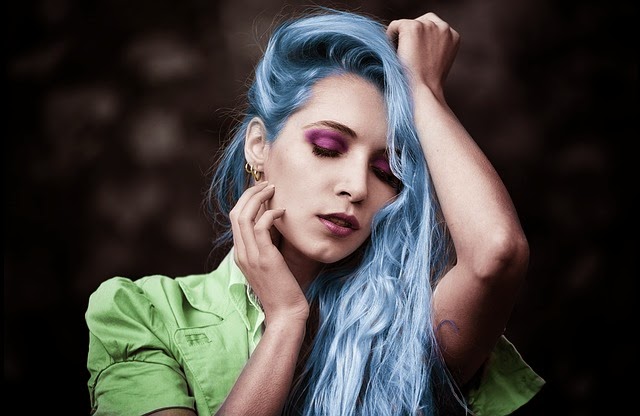 Permanent hair dye allows you to make anything from a subtle change to a more drastic transformation of the way you look, without worrying about the color washing out.
Permanent hair dye allows you to make anything from a subtle change to a more drastic transformation of the way you look, without worrying about the color washing out.This comes at a price however. When you decide to change your hair color, you can't simply dye over it with a lighter shade in most cases because dye won't lift dye. It's fine if the new color you want is darker than your current shade, but if you want a lighter color, you need to know how to remove permanent hair dye before you can achieve this.
How permanent hair dye works
Your hair is comprised of three main structures: the medulla, cortex, and cuticles. The cortex is the inner area of the hair shaft where hair color is located, and in order for permanent dye to change the way your hair looks, dye needs to penetrate into this area.
However, this part of the hair shaft is well-protected by a layer of scale-like structures called cuticles. Cuticles seal your hair against the external environment to protect it and maintain moisture. Heat and alkalinity cause these structures to open, but acidity and cold temperatures seal them back up. Permanent dye opens the hair shaft by creating an alkaline environment, and this allows the dye to penetrate.
Once the dye molecules reach the cortex, a chemical reaction occurs that bonds them together into larger molecules that are too big to be washed back out of the hair again. This is why the dye is permanent. Temporary dyes work by staining the surface of the hair, meaning that this kind of dye gradually washes out.
Reversing the process
Permanent dye is made permanent through a chemical process called oxidation that bonds the molecules together, and this can actually be reversed to break the dye back down and allow it to be washed out of your hair.
Hair dye remover is a product that allows you to reverse the reaction to break down and remove permanent dye. The most significant benefit to using it, however, is that unlike bleach, hair dye remover is non-damaging and won't cause the condition of your hair to weaken after use.
How to remove hair color - If your dye isn't permanent, dye remover won't work, but there are other ways to remove temporary hair dyes and you'll find them here...
What is hair dye remover?

Hair dye remover can be used to remove permanent hair dye by reversing the process that makes it permanent, but there are a few factors to take into consideration before you use it.
Hair dye remover is best used on hair that has either only been dyed once with the new color, or when there is not already a heavy buildup of previous dye. The more times a dye has been applied, and the more dye that has been applied in total before use of the product, the less effective it tends to be because of the sheer amount of color that needs to be removed.
Even in cases where it is less effective though, dye remover is still a good first step in removing permanent hair dye before using other products like bleach to finish stripping the hair. Doing so reduces damage by allowing you to bleach your hair less, and even helps the bleach lighten more effectively, in less time.
How to use hair dye remover
Hair dye remover is packaged as two separate solutions that need to be mixed together when you intend to use it. One solution is a reducing agent which breaks down the dye, and the other solution is based on citric acid, which catalyses the reaction.
Once mixed, the reaction begins and the product will lose effectiveness over time as this continues. This is why it needs to be mixed right before application and leaving it in for longer won't necessarily lead to better results as it will eventually stop working.
To use hair dye remover to remove permanent hair dye, apply the product quickly and evenly to all hair. The product will have no effect on your natural hair color, so any regrowth won't change. Only dyed hair that has been colored with permanent dye will change during this process.
When your hair has been completely covered, allow it to process for up to 20 minutes. The change your hair shows during this time is often remarkably rapid and great to watch as the dye breaks down. The lighter your hair has been in the past, and the darker the color that was applied, the more extreme the change will be during this time.
After the product has processed and the change in color has slowed or stopped, rinse the product with water and immediately wash it with clarifying shampoo. Repeat this up to three times and ensure that you wash it as thoroughly as possible. This step is very important because the dye that has been broken down can oxidise and return to its previous color. The shampoo removes the broken down dye from your hair, and the more thoroughly and completely you shampoo it, the less likely there will be any re-darkening of your hair.
Follow this shampoo step with a heavy conditioning treatment and allow your hair to rest for up to 3 days to regain moisture balance. Dye remover isn't damaging, but the remover and shampooing do cause a lot of dryness because they will strip natural oil off your hair. Conditioners reverse this by adding moisture back in, and resting your hair allows the natural oils to return.
Lightening further
If you need to lighten your hair further after using dye remover, this can be done with bleach after your hair has rested. It's important not to bleach hair that is suffering from dryness, so this shouldn't be done immediately after using dye remover. Dry hair is brittle and much more susceptible to damage from bleaching or dyeing.
You can also use hair dye remover more than once if necessary to remove more dye. However, it's normal for a small amount of dye to remain regardless and you can't always remove all traces of color by just using dye remover alone. It can also only take you to the lightest color you have been in the past, because it doesn't affect natural pigment and won't lighten it.
Color correction after removal
Following dye removal, there is one last step that needs to be taken to get your hair either close to its original color, or to a new color. As permanent dye lightens your natural pigment slightly, even when you apply a darker shade, the color you're left with after removal can be slightly warmer and lighter than what it used to be. If the dye remover hasn't completely removed the color, what is left will also be very warm and need toning to take it to a natural looking color.
To tone it, use an ash shade, two levels lighter than your current level. Your hair will be porous and can end up darker when dyeing immediately after using dye remover or bleach, and using a lighter shade for toning helps to ensure it tones properly and doesn't end up too dark.
More information:
- How to choose a new hair color - Discover how to decide on shades of hair color that are achievable and match your features...
- How often should you dye your hair? - Like dyeing your hair but worried about the condition of your hair? Find out how often each type of dye should be used to keep your hair healthy...
- How to get healthy hair - Hair that is in good condition is strong and beautiful. Find out how to maintain your hair and treat the most common problems...
Have a question about how to remove permanent hair dye or need help reaching a new color? Leave a comment for tailored advice.


No comments:
Post a Comment